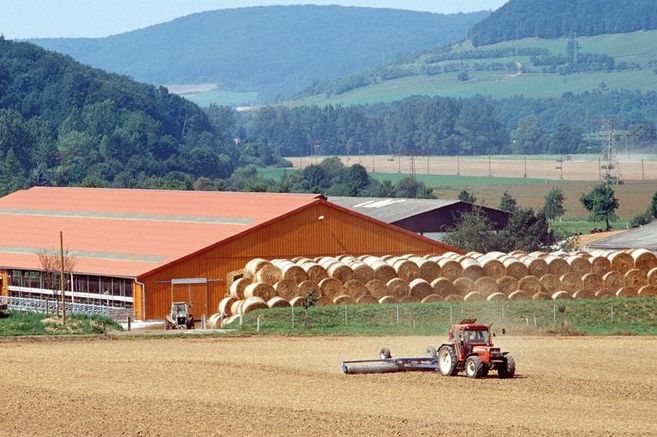

Institut für
BW Betriebswirtschaft
Zeitschriftenbeiträge
Beiträge in referierten Zeitschriften von Walter Dirksmeyer
- 0
Yoon J-K, Dirksmeyer W (2024) Financial effects of reducing the use of peat in blueberry production systems. DGG Proc Short Comm 12(2), DOI:10.5288/dgg-pr-12-02-jy-2024
- 1
Isaak M, Ludwig-Ohm S, Dirksmeyer W (2023) Challenge of implementing Horticulture 4.0 innovations in the value chain. Acta Hortic 1380:135-144, DOI:10.17660/ActaHortic.2023.1380.17
- 2
Feldmann F, Bloem E, Dirksmeyer W, Golla B, Greef JM, Piorr A, Saltzmann J, Vogler U (2023) Definition gebräuchlicher Begriffe der urbanen Landwirtschaft und englischer Entsprechungen. J Kulturpfl 76(1-2):2-8, DOI:10.5073/JfK.2023.01-02.02
- 3
Dirksmeyer W, Isaak M (2023) Rechtliche Rahmenbedingungen und Förderung der urbanen Landwirtschaft. J Kulturpfl 76(1-2):49-54, DOI:10.5073/JfK.2023.01-02.06
- 4
Ludwig-Ohm S, Hildner P, Isaak M, Dirksmeyer W, Schattenberg J (2023) The contribution of Horticulture 4.0 innovations to more sustainable horticulture. Procedia Comput Sci 217:465-477, DOI:10.1016/j.procs.2022.12.242
- 5
Yoon J-K, Dirksmeyer W (2023) The economic impacts of peat reduction in the potted basil production system. DGG Proc Short Comm 11(2):1-8, DOI:10.5288/dgg-pr-11-02-jy-2023
- 6
Ludwig-Ohm S, Dirksmeyer W (2021) HortiCo 4.0: the networking and transfer project for horticulture 4.0 innovation funding in Germany. Acta Hortic 1327:817-822, DOI:10.17660/ActaHortic.2021.1327.108
- 7
Kretzschmann A, Dirksmeyer W (2021) Quantification of the amount of peat and substrate used in tree nurseries in Germany. Acta Hortic 1327:479-486, DOI:10.17660/ActaHortic.2021.1327.63
- 8
Ludwig-Ohm S, Dirksmeyer W, Klockgether K (2019) Approaches to reduce food losses in German fruit and vegetable production. Sustainability 11(23):6576, DOI:10.3390/su11236576
- 9
Ludwig-Ohm S, Dirksmeyer W (2019) REFOWAS-Fallstudie Obst und Gemüse: Lebensmittelverluste in Verarbeitungsindustrie und Lebensmitteleinzelhandel (LEH). DGG Proc Short Comm 9(2):1-5, DOI:10.5288/dgg-pr-so-2019
- 10
Ludwig-Ohm S, Klockgether K, Dirksmeyer W (2017) Lebensmittelverluste in der deutschen Gemüseproduktion - Erkenntnisse aus Fallstudien zur Erzeugung von Salat und Möhre. DGG Proc Short Comm 7(6):1-5, DOI:10.5288/dgg-pr-sl-2017
- 11
Efken J, Dirksmeyer W, Kreins P, Knecht M (2016) Measuring the importance of the bioeconomy in Germany: Concept and illustration. NJAS Wageningen J Life Sci 77:9-17, DOI:10.1016/j.njas.2016.03.008
- 12
Fluck K, Dirksmeyer W (2015) Analysis of the economic importance of the German horticultural cluster. Acta Hortic 1099:533-539
- 13
Garming H, Strohm K, Dirksmeyer W (2015) Effects of structural change and international trade on profitability of apple production in Europe and South Africa. Acta Hortic(1103):143-149, DOI:10.17660/ActaHortic.2015.1103.22
- 14
Lindemann T, Dirksmeyer W (2015) Typical cauliflower production systems in Germany. Acta Hortic 1103:197-202, DOI:10.17660/ActaHortic.2015.1103.29
- 15
Strohm K, Dirksmeyer W, Garming H (2014) International analysis of the profitability of wine grape production [online]. DGG Proc Short Comm 4(1):1-5, zu finden in <http://www.dgg-online.org/proceedings/vol-04-2014/dgg-pr-04-01-ks-2014.pdf> [zitiert am 12.12.2014]
- 16
Lindemann T, Dirksmeyer W (2014) Produktionsökonomik des Blumenkohlanbaus in Deutschland. DGG Proc Short Comm 4(7):1-5
- 17
Dirksmeyer W, Fluck K (2013) Die wirtschaftliche Bedeutung des Gartenbausektors in Deutschland. DGG Proc Short Comm 3(15):1-5, DOI:10.5288/dgg-pr-03-15-kf-2013
- 18
Ludwig-Ohm S, Dirksmeyer W (2013) Zur Wettbewerbsfähigkeit des Gemüsebaus in Deutschland. DGG Proc Short Comm 3(14):1-5, DOI:10.5288/dgg-pr-03-14-sl-2013
Beiträge in nicht referierten Zeitschriften von Walter Dirksmeyer
- 0
Ludwig-Ohm S, Dirksmeyer W (2020) Vernetzung. Synergien. Transfer. HortiCo 4.0. ZVG Gartenbau Report 46(3):14
- 1
Schmidt TG, Baumgardt S, Blumenthal A, Burdick B, Claupein E, Dirksmeyer W, Hafner G, Klockgether K, Koch F, Leverenz D, Lörchner M, Ludwig-Ohm S, Niepagenkemper L, Owusu-Sekyere K, Waskow F (2019) Wege zur Reduzierung von Lebensmittelabfällen. Agra Europe (Bonn) 60(47):D1-27
- 2
Behr HC, Dirksmeyer W (2019) Wo landet unser Obst? : Warenstromanalyse für Tafelobst. Obstbau(5):198-200
- 3
Garming H, Dirksmeyer W, Bork L (2018) Der Obstbau diversifiziert sich. Agra Europe (Bonn) 59(41):M8-9
- 4
Garming H, Dirksmeyer W, Bork L (2018) Entwicklungen des Obstbaus in Deutschland von 2005 bis 2017. Agra Europe (Bonn) 59(41):D1-53
- 5
Dirksmeyer W, Garming H, Klockgether K (2017) Chancen durch Vielfalt. Agrarmanager(1):10-13
- 6
Ludwig-Ohm S, Dirksmeyer W, Homeister H (2017) HortInnova stellt die Weichen für die Zukunft : Forschungsstrategie für Innovationen im Gartenbau. Dt Baumschule 69(12):14-17
- 7
Strohm K, Garming H, Dirksmeyer W (2016) Entwicklung des Gemüsebaus in Deutschland von 2000 bis 2015: Anbauregionen, Betriebsstrukturen und Handel - Auszüge des Thünen Working Papers 56. Agra Europe (Bonn) 57(24):D1-27
- 8
Garming H, Dirksmeyer W (2015) Obstbau 2020 : der deutsche Obstbau im Wandel. Obstbau(7):402-407
- 9
Dirksmeyer W, Hardeweg B (2013) Bedeutung des Gartenbaus in Deutschland - ein Überblick : Vorstellung der aktuellen Clusterstudie. TASPO 146(23):10-11
- 10
Dirksmeyer W (2013) Beitrag ergänzender Wirtschaftszweige im Gartenbaucluster sehr hoch. TASPO 147(34):8-9
- 11
Ludwig-Ohm S, Dirksmeyer W (2012) Ausbildung im Gartenbau – eine Situationsanalyse. TASPO(4):8
- 12
Dirksmeyer W (2012) Perspektiven des deutschen Gartenbaus. Obstbau(3):175-176
- 13
Dirksmeyer W (2010) Verringerung der Pflanzenschutzmitteleinsatzes im Freilandgemüsebau ist möglich. Monatsschr Mag Gartenbau Profi 98(1):14-16
- 14
Dirksmeyer W, Sourell H, Lübbe E (2009) Einfluss des Klimawandels auf den Beregnungsbedarf. TASPO 143(21):8
- 15
Dirksmeyer W (2009) Rohr- und Tropfbewässerung rechnet sich nur bei Mehrerträgen : Verbote der Grundwasserentnahme könnten gärtnerische Betriebe massiv treffen. TASPO 143(30):10-11
- 16
Dirksmeyer W (2009) Strukturwandel: noch mitten drin : Status quo und Perspektiven des deutschen Zierpflanzenbaus. TASPO 143(48):11
- 17
Dirksmeyer W (2008) AFP schützt nicht vor zusätzlicher Arbeit. Land Forst 161(34):12-13
- 18
Dirksmeyer W (2008) AFP unter die Lupe genommen : Direktvermarkter profitieren vom Agrarinvestitionsförderungsprogramm. Bayer Landwirtsch Wochenbl 198(27):63
- 19
Dirksmeyer W (2008) Was bringt die Förderung von Investitionen? Rhein Bauernzeitg 62(26):18-20
- 20
Dirksmeyer W (2007) Agrarinvestitionsförderung aus der Sicht geförderter Gärtner : Ergebnisse aus Nordrhein-Westfalen, Hamburg und Sachsen. TASPO 141(46):6-7
- 21
Dirksmeyer W (2007) Does IPM pay off in Europe? Pesticides News(77):7-9
- 22
Forstner B, Bergschmidt A, Dirksmeyer W, Ebers H, Margarian A (2006) Bewertung der Agrarinvestitionsförderung in Deutschland. Agra Europe (Bonn) 41(36):S1-9
- 23
Dirksmeyer W, Waibel H, Belder E, Esbjerg P (2006) Comparison of pest control practices in open field vegetables among three European countries. IOBC WPRS Bull 28(4):83-99
- 24
Dirksmeyer W (2006) Economics of biological control in open field vegetable production - a methodological introduction. IOBC WPRS Bull 28(4):73-82






